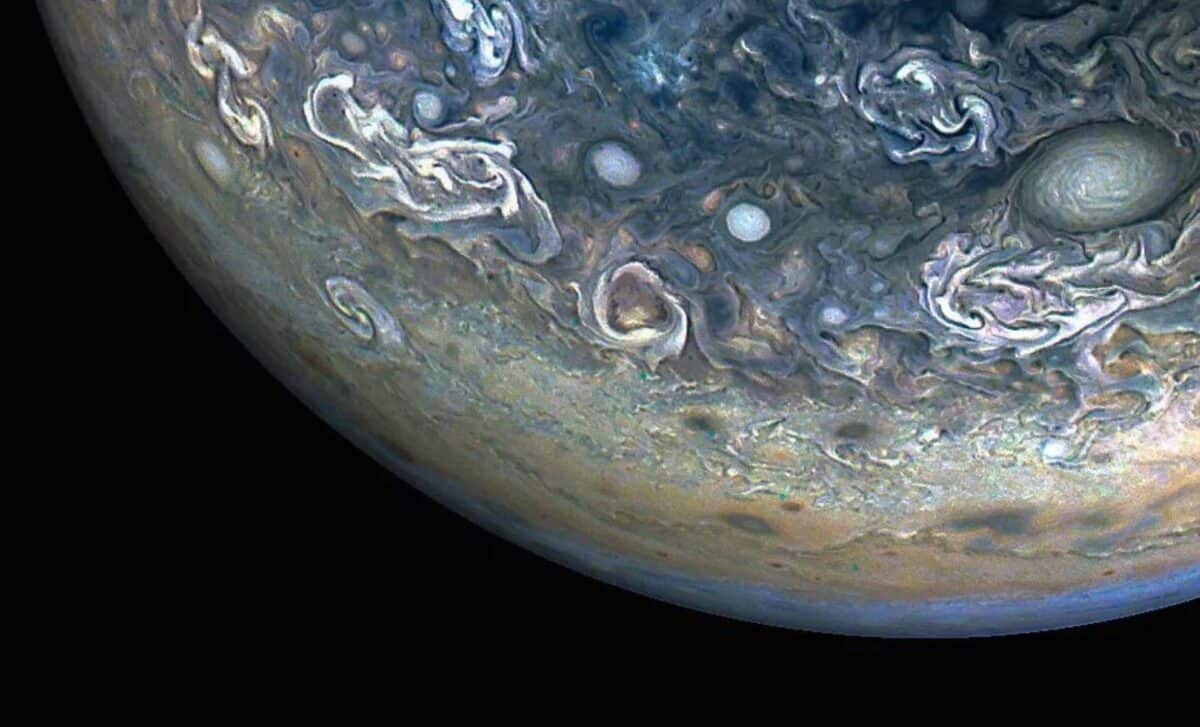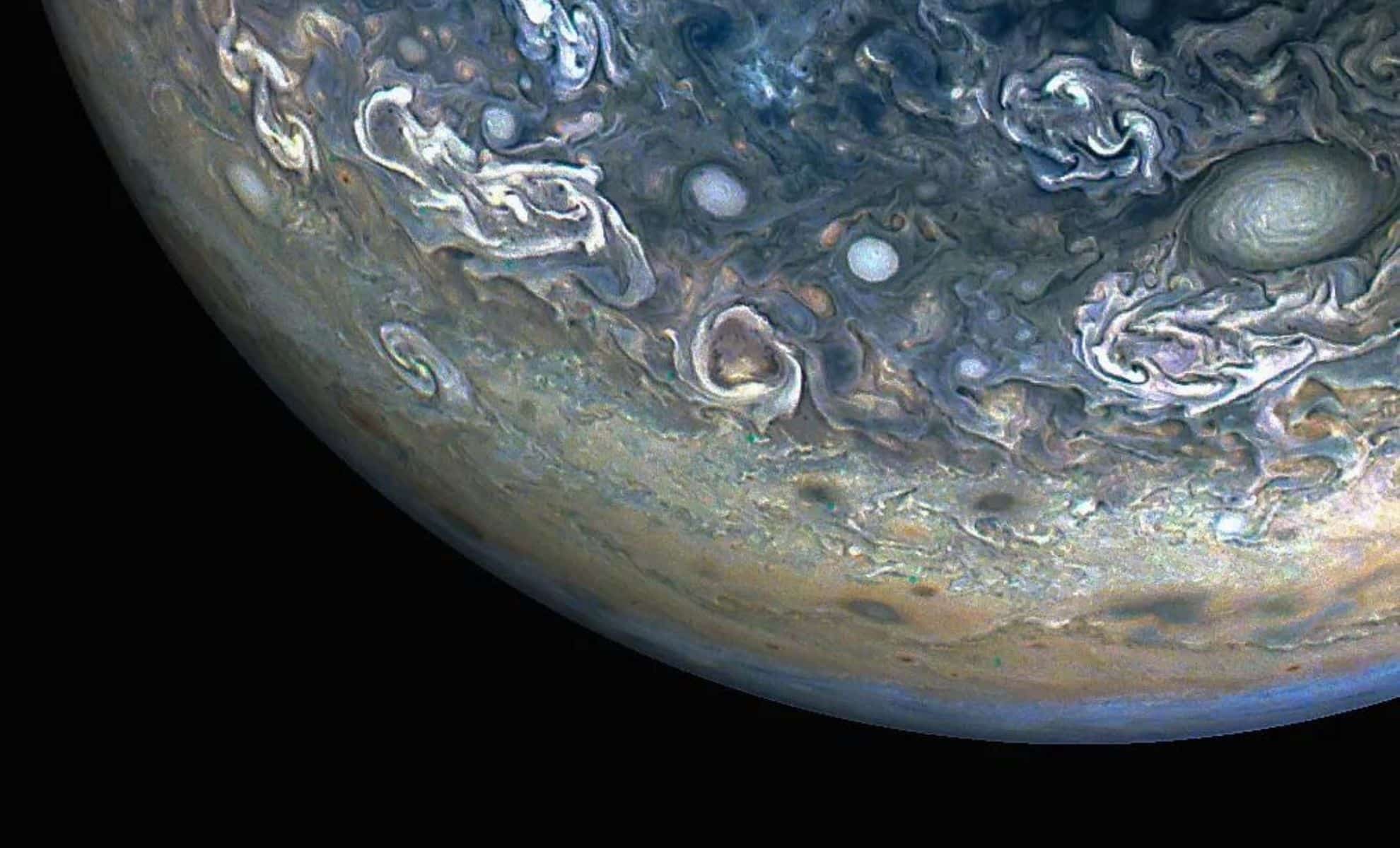NASA’s Juno spacecraft, which has been orbiting Jupiter since 2016, continues to provide unprecedented insights into the gas giant’s atmosphere.
During its 61st close flyby on May 12, 2024, Juno captured a stunning color-enhanced image of Jupiter’s northern hemisphere, showcasing the planet's dynamic and chaotic cloud patterns.
This image offers a detailed view of the complex atmospheric conditions that characterize Jupiter, providing valuable data for scientists studying planetary atmospheres.
Exploring Jupiter’s Northern Hemisphere
The recent flyby allowed Juno to photograph an area known as the folded filamentary region. This region is characterized by its turbulent cloud structures and cyclonic storms, which evolve rapidly over just a few days. The zonal jets, which typically create Jupiter’s familiar banded patterns, break down in these areas, leading to the chaotic cloud formations observed.
Citizen scientist Gary Eason processed the raw data from the JunoCam instrument to enhance the color and clarity of the image. At the time the image was taken, Juno was approximately 18,000 miles (29,000 kilometers) above Jupiter's cloud tops, at a latitude of about 68 degrees north of the equator. This high-altitude perspective provides a clear and detailed view of the planet's atmospheric dynamics.
The Role of Citizen Science
Citizen scientists like Gary Eason play a crucial role in NASA’s missions by processing raw images from spacecraft like Juno. Eason utilized digital processing techniques to bring out the vivid colors and intricate details of Jupiter’s cloud patterns. This collaborative effort between NASA and the public not only enhances the visual appeal of the images but also aids scientific analysis by highlighting features that might otherwise go unnoticed.
JunoCam’s raw images are publicly available for anyone to process. NASA encourages enthusiasts to participate in this endeavor by visiting the JunoCam Processing website. This initiative helps to engage the public in space exploration and contributes to the broader scientific community’s understanding of Jupiter.
Insights from Juno’s Observations
Juno’s observations provide valuable insights into the atmospheric dynamics of Jupiter. The folded filamentary regions, in particular, are of great interest to scientists. These areas reveal the interplay of different atmospheric forces that create the planet's distinct cloud formations and weather patterns. By studying these regions, researchers hope to gain a deeper understanding of the mechanisms driving Jupiter’s atmospheric behavior.
The data collected by Juno contribute to a broader understanding of planetary atmospheres, including those of Earth. Comparing the atmospheric phenomena on Jupiter with those observed on other planets allows scientists to refine their models of atmospheric dynamics and improve predictions of weather and climate systems. This knowledge is crucial for understanding the fundamental processes that shape planetary environments across the solar system.
The Broader Impact of Juno’s Mission
Launched in 2011, Juno’s primary mission is to understand Jupiter's origins, structure, atmosphere, and magnetosphere through long-term close-up observations. Since entering Jupiter's orbit in 2016, Juno has provided unprecedented insights into the planet's dynamics. The spacecraft's suite of scientific instruments has allowed researchers to peer below the cloud cover, revealing the complexities of Jupiter's atmospheric conditions and magnetic field.
The folded filamentary regions, observed in this flyby, are particularly intriguing to scientists. These areas show the interplay of different atmospheric forces that create the planet's distinct cloud formations and weather patterns. By studying these regions, researchers hope to gain a deeper understanding of the mechanisms driving Jupiter's atmospheric behavior.
Juno’s discoveries have implications that extend beyond Jupiter. By enhancing our understanding of the largest planet in our solar system, Juno's findings help scientists make sense of the atmospheric dynamics on other planets, including Earth. This comparative approach enriches our knowledge of planetary science and supports the development of more accurate models for predicting weather and climate changes on our own planet.




